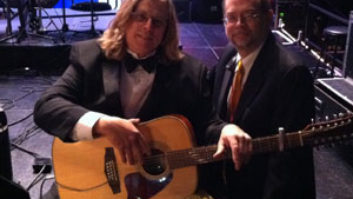For their 1998 Christmas tour, the Pops carried their own production for the first time in the group’s touring history, squeezing sound and lights into a single truck. Mix caught the show at Portland’s Rose Garden Arena. It was one of a dozen arena shows featuring the Pops in their run up the West Coast. “While it is always a pleasure to work with regional sound companies, there’s obviously no substitute for the advantages of flying the same rig every night,” says the Pops’ FOH engineer Steve Colby. New England-based Scorpio Sound supplied a Crest-powered EAW sound system. Crew chief Carl Gagnon handled system tech duties with Mark MacArthur taking care of the forest of microphones onstage.
Left and right main arrays comprise KF/BH 853 and KF850 cabinets and are custom-configured for each venue by Scorpio’s Gagnon. In Portland, four SB 1000 subs were stacked on the floor at each down-stage corner, JF 200s served as under-hung downfills, and JF 80s placed along the lip of the stage reproduced vocals and announcements.
Gagnon tunes the P.A. each day before handing the reins over to Colby. “Carl has an incredible ear and a real knack for getting the very best out of the system every day. I rarely make more than small, very subjective changes to system EQ after he’s finished,” says Colby, whose favorite system equalizer is the BSS VariCurve. “There’s nothing better than being able to take the remote controller, walk around to representative seats and tweak.
Gagnon notes that using a vocal mic and the mantra of “check-one-two” is the wrong way to adjust system EQ for symphony reinforcement, which requires a smooth and even system response. “A lot of times for rock you’re EQ’ing the system so you can run your vocal input fairly flat, but with the symphony it’s more about making it sound natural,” explains Gagnon. He recommends starting with an analyzer to get the system as flat as possible, but then using listening material to hear what frequencies are sticking out. “We’re trying to give the impression that the music is coming from the stage, rather than the speakers,” says Gagnon. “The orchestra is heavy in the 300 to 400Hz area, so we try to take a little more of that out of the EQ to compensate.”
Gagnon stresses that the P.A. must be exceptionally quiet and free of hums and buzzes. “You have to pay more attention to detail if you want the show to come off well,” he notes. “Crowds that come to symphony shows want the P.A. to sound natural and transparent, and not get in the way of the music.”
Five monitor mixes from the FOH console feed HotSpot speakers placed in various sections of the orchestra. Colby prefers the HotSpots because of their compact size and their restricted ability to reproduce low frequencies that could adversely affect the sound onstage. Each monitor is fitted with a volume control, enabling the musicians to adjust the level within a preset window. Without daily soundchecks, Colby notes, this is essential for the comfort of the players.
The show has modest effects requirements-Colby uses only two digital reverbs. For Colby, reverb is the glue in the mix, and he favors the hall sounds that Lexicon offers. “If it’s not noticeable, it’s working,” he comments. Colby puts many of the instruments in the primary reverb, but at different levels-strings to provide some sheen, a little more on woodwinds to give them dimension. A second reverb is reserved for a vocal soloist and for the chorus that joins the Pops for the Christmas presentations.
Practical matters of time, cost and a tight travel schedule prevent a daily soundcheck, so Colby often starts with a rough setup of default console settings. “Nine times out of ten, however, our only soundcheck is when the concert master stands to tune the orchestra,” Colby laments. “Typically, the show peaks around 93 dB. Our target for the performance is to achieve the same dynamic range you would have at our home at Symphony Hall in Boston.” However, due to the lack of intimacy in an arena, Colby often attempts to compensate by making the sound a little punchier or brighter.



